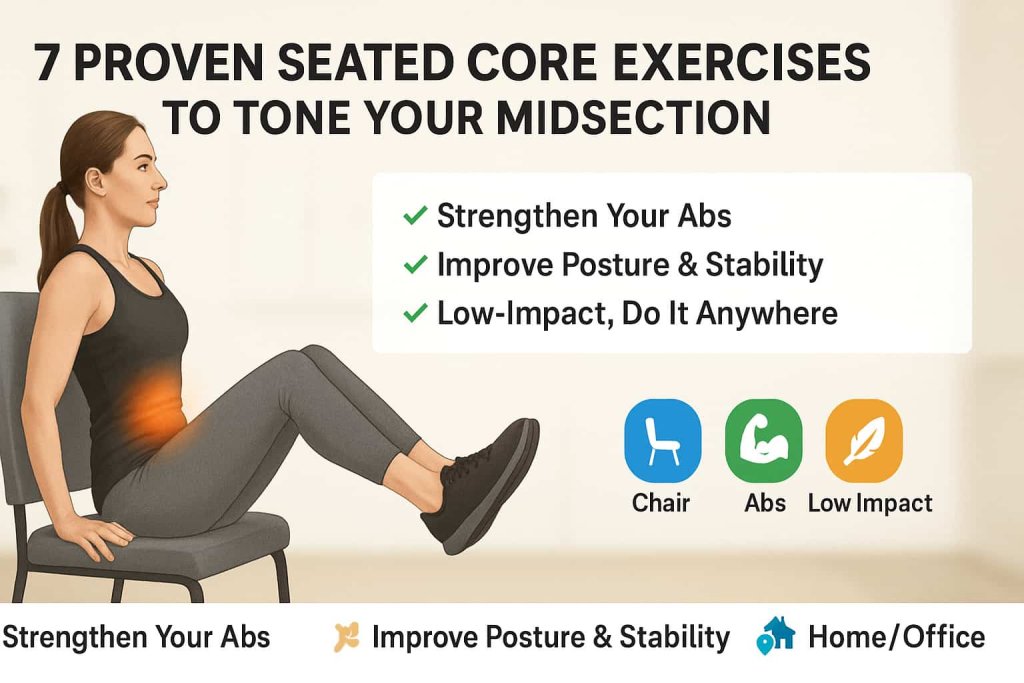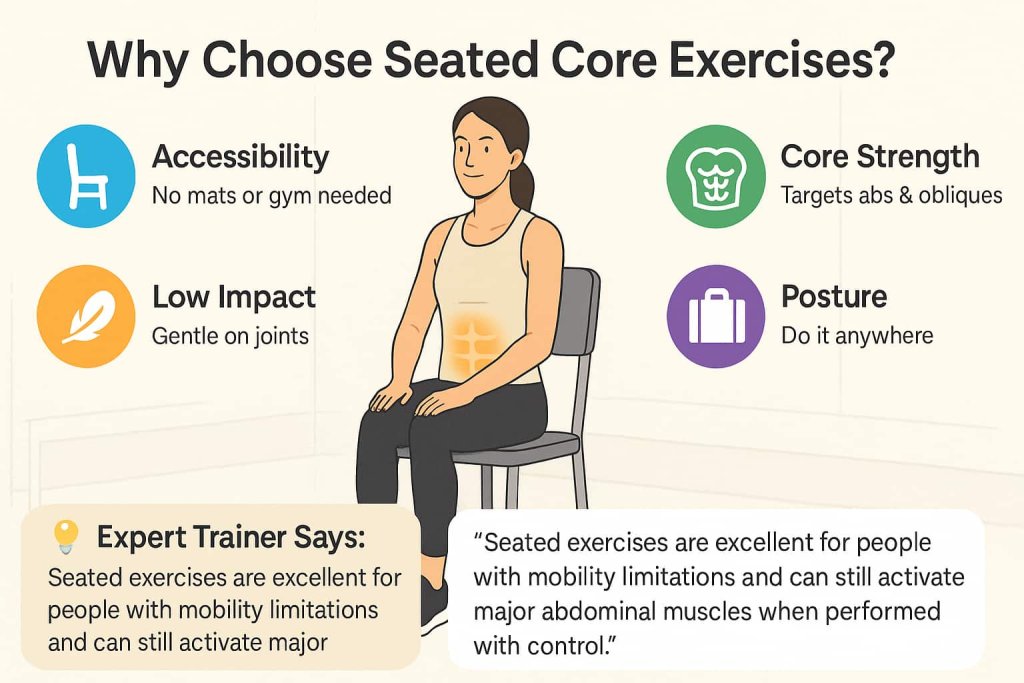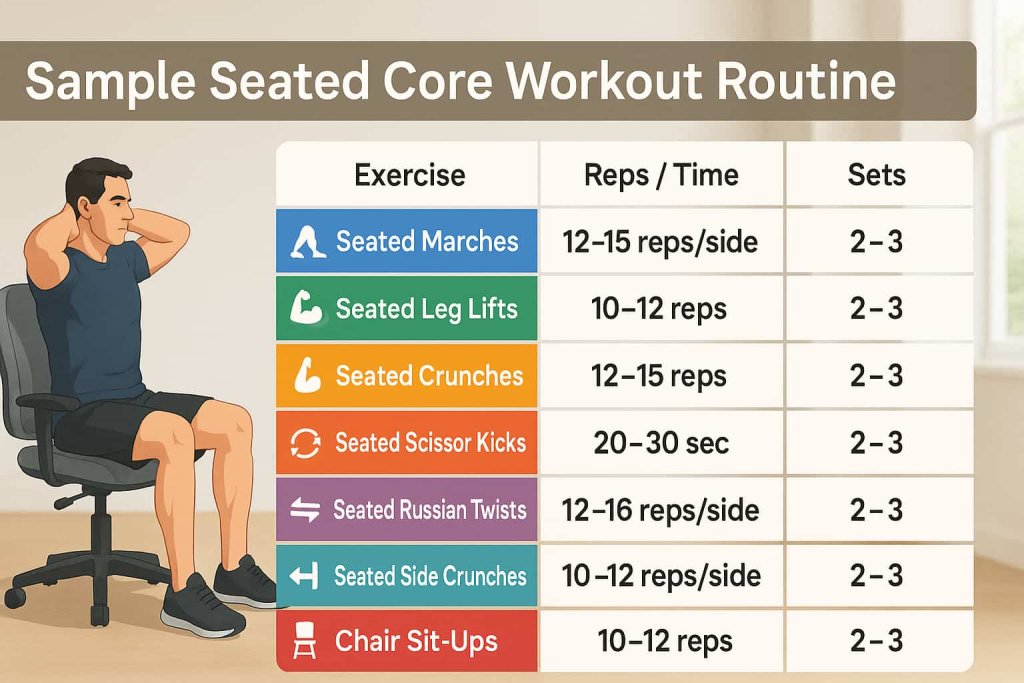Yes, seated core exercises can effectively tone your midsection while improving posture and stability. These simple movements target your abs and obliques without requiring floor space, making them perfect for seniors, office workers, or anyone who prefers low-impact workouts.

Understanding seated core training is important because a strong midsection supports your spine, reduces injury risk, and enhances everyday movements. The best part? You only need a sturdy chair—no gym required. Below, we’ll cover 7 proven seated core exercises, a step-by-step routine, benefits, and expert tips to maximize your results.
Why Choose Seated Core Exercises?

- Accessibility: No need for mats, gyms, or advanced mobility.
- Core Strength: Targets rectus abdominis, obliques, and deep stabilizers.
- Low Impact: Gentle on joints and suitable for seniors.
- Posture & Stability: Stronger abs help you sit and stand taller.
- Versatility: Can be done at home, at the office, or while traveling.
Expert Trainer Says: “Seated exercises are excellent for people with mobility limitations and can still activate major abdominal muscles when performed with control.”
7 Proven Seated Core Exercises
If you want to tone your abs but can’t get down on the floor—or you simply prefer low-impact moves—seated core exercises are a perfect solution. They strengthen your abs, obliques, and stabilizing muscles without stressing your joints. These exercises are ideal for beginners, office workers, seniors, or anyone short on space.
Below are 7 seated ab workouts you can do anytime with just a sturdy chair.
1. Seated Marches
Why it works: This simple move mimics walking but targets your lower abs by forcing your core to stabilize as each knee lifts.
Muscles Worked: Lower abs, hip flexors, stabilizers.
How to Do It:
- Sit upright on a chair with feet flat.
- Place hands on the sides of the chair for light support.
- Lift your right knee toward your chest, then lower.
- Repeat with the left knee.
- Perform 12–15 reps per side.
Trainer Tip: Keep your torso tall—avoid leaning back. For extra challenge, hold a light dumbbell or ball on top of your thighs.
2. Seated Leg Lifts
Why it works: Lifting both legs off the ground forces your abs to work harder to control the movement.
Muscles Worked: Lower abs, deep core stabilizers.
How to Do It:
- Sit near the edge of the chair.
- Lean back slightly, gripping the chair sides.
- Lift both legs until straight and parallel to the floor.
- Hold for 2–3 seconds, then lower with control.
- Perform 10–12 reps.
Trainer Tip: If straightening legs is tough, keep knees bent. Over time, work toward full extension.
3. Seated Crunches
Why it works: A classic ab move done upright. It engages your rectus abdominis—the “six-pack” muscles—without floor work.
Muscles Worked: Rectus abdominis, hip flexors.
How to Do It:
- Sit tall with feet flat.
- Cross arms over your chest or place fingertips behind your ears.
- Slowly lean back until your abs tighten.
- Return to upright position.
- Perform 12–15 reps.
Trainer Tip: Move slowly—speed reduces effectiveness. Exhale as you crunch forward to maximize contraction.
4. Seated Scissor Kicks
Why it works: This dynamic exercise strengthens your lower abs while improving hip stability.
Muscles Worked: Lower abs, hip flexors, inner and outer thighs.
How to Do It:
- Sit slightly back, holding the sides of the chair.
- Lift both legs a few inches off the ground.
- Cross one leg over the other, alternating like scissors.
- Continue for 20–30 seconds.
Trainer Tip: Keep movements small and controlled. Avoid swinging your legs—focus on the core.
5. Seated Russian Twists
Why it works: Rotational core work builds oblique strength and improves your ability to twist, bend, and stabilize your spine.
Muscles Worked: Obliques, transverse abdominis, spinal stabilizers.
How to Do It:
- Sit upright, leaning back slightly.
- Lift your feet off the floor if possible.
- Clasp your hands together in front of your chest.
- Twist your torso to the right, then left, keeping abs engaged.
- Perform 12–16 reps per side.
Trainer Tip: For added challenge, hold a dumbbell, medicine ball, or water bottle as resistance.
6. Seated Side Crunches
Why it works: Side crunches improve lateral stability and target the often-neglected obliques.
Muscles Worked: Obliques, QL (quadratus lumborum), core stabilizers.
How to Do It:
- Sit tall with feet flat.
- Place hands lightly behind your head.
- Bend your torso sideways, bringing elbow toward hip.
- Return upright and switch sides.
- Perform 10–12 reps per side.
Trainer Tip: Avoid pulling on your neck. Focus on using your side abs to drive the motion.
7. Chair Sit-Ups (Seated Roll-Backs)
Why it works: This controlled roll-back engages the full core, mimicking a sit-up but without floor strain.
Muscles Worked: Entire core (rectus abdominis, obliques, erector spinae).
How to Do It:
- Sit on the edge of the chair.
- Cross arms over your chest.
- Lean back slowly until abs engage.
- Return upright with control.
- Perform 10–12 reps.
Trainer Tip: Move through a comfortable range of motion—don’t lean too far if it strains your lower back.
Sample Seated Core Workout Routine

| Exercise | Reps / Time | Sets |
|---|---|---|
| Seated Marches | 12–15 reps/side | 2–3 |
| Seated Leg Lifts | 10–12 reps | 2–3 |
| Seated Crunches | 12–15 reps | 2–3 |
| Seated Scissor Kicks | 20–30 sec | 2–3 |
| Seated Russian Twists | 12–16 reps/side | 2–3 |
| Seated Side Crunches | 10–12 reps/side | 2–3 |
| Chair Sit-Ups | 10–12 reps | 2–3 |
Frequency: Perform 3–4 times per week.
Progression: Add light dumbbells or increase reps for greater challenge.
Benefits of Seated Core Training
- Tones Midsection: Activates abs and obliques for visible definition.
- Improves Balance: Strengthens stabilizing muscles for daily movement.
- Supports Back Health: Reduces spinal stress by building abdominal endurance.
- Great for Seniors & Desk Workers: Recommended for mobility, fall prevention, and posture.
Pro Tips for Success
- Use a stable, non-wheeled chair.
- Move slowly—avoid momentum.
- Keep chest lifted, core braced.
- Pair with cardio + healthy nutrition for best fat-loss results.
FAQs About Seated Core Exercises
1. Can seated core exercises burn belly fat?
They strengthen abs but won’t directly burn fat. Pair them with cardio and nutrition for fat loss.
2. Are seated ab workouts safe for seniors?
Yes—low-impact and recommended for stability, but consult a doctor if you have back or hip issues.
3. How long until I see results?
With consistency, you can feel stronger in 2–4 weeks and see visible toning in 6–8 weeks.
4. Do I need equipment?
No. A sturdy chair is enough. You can add a dumbbell or medicine ball for extra resistance.
5. Can I do these daily?
Yes, but 3–4 sessions per week is enough for results while allowing recovery.
6. Do they help with posture?
Yes—stronger abs support your spine and reduce slouching.
7. What’s the best time of day to do them?
Anytime—morning energizer, mid-day office break, or evening routine.
Conclusion
Seated core exercises are a simple yet powerful way to strengthen and tone your abs—without a gym or floor mat. Whether you’re at home, at work, or in recovery, these 7 proven moves can help you build stability, improve posture, and sculpt your midsection.
👉 Start today with just 10 minutes a few times per week—your core (and confidence) will thank you!
References
- Klempel N, Tully M, et al. (2021). The Effect of Chair-Based Exercise on Physical Function in Older Adults: A Systematic Review & Meta-analysis. International Journal of Environmental Research and Public Health. Read Study
- Efendi F, et al. (2022). Effects of Chair-Based Resistance-Band Exercise on Physical Function, Sleep, and Depression in Long-Term Care: Systematic Review & Meta-analysis. Journal of Geriatric Physical Therapy. Read Study
- Tew G, et al. (2024). Chair-Based Yoga for Older Adults with Long-Term Conditions: A Pragmatic Randomized Controlled Trial. BMC Geriatrics. Read Study
- World Health Organization. (2020). WHO Guidelines on Physical Activity and Sedentary Behaviour. Geneva: WHO. Official Guidelines
